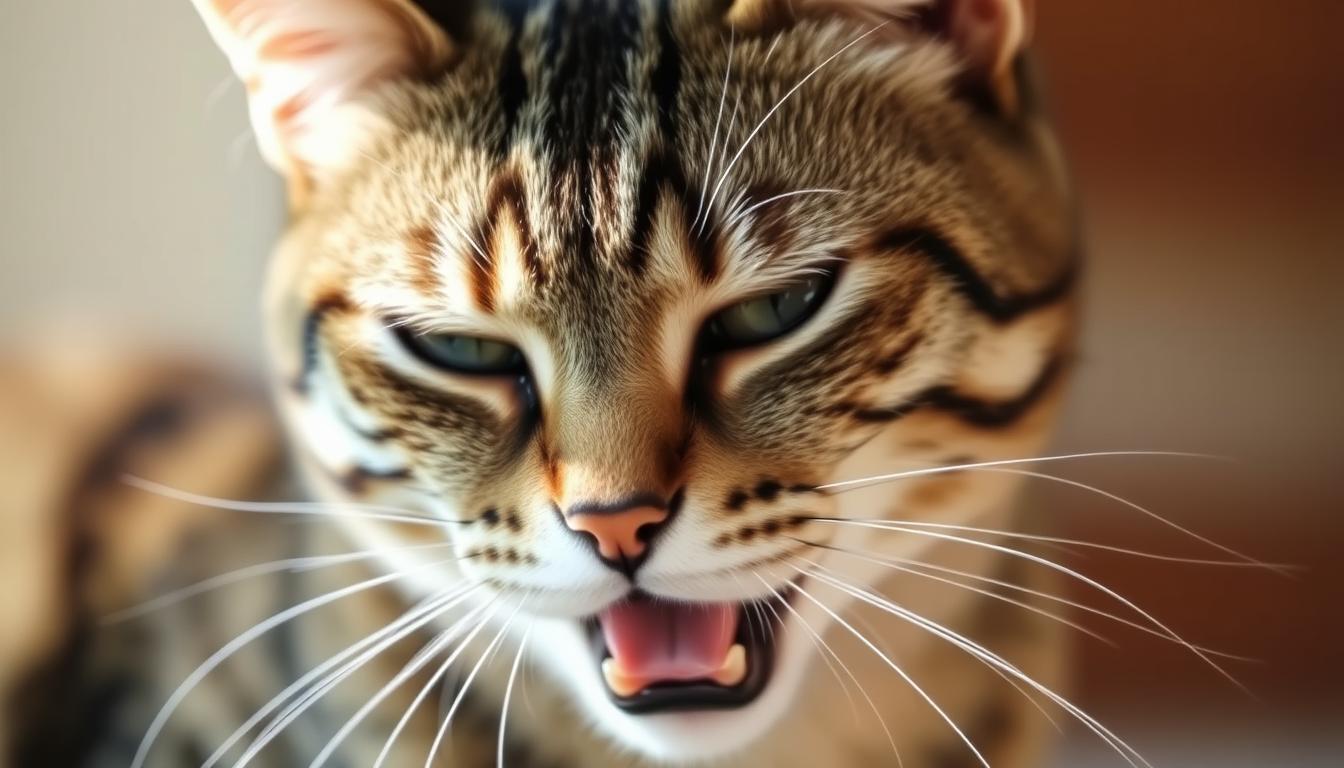One evening, Sarah noticed her normally playful tabby, Whiskers, hunched over with a raspy cough. Though initially dismissing it as a hairball, she grew concerned when the episodes persisted. A visit to the vet revealed Whiskers had feline asthma—a condition requiring prompt care. This scenario underscores how seemingly minor symptoms can signal deeper health issues in pets.
Coughing in felines serves as both a natural reflex and a potential red flag. While occasional throat-clearing is normal, recurrent or phlegm-filled episodes often point to respiratory infections, allergies, or chronic conditions like bronchitis. Recognizing patterns—such as frequency, sound, or accompanying lethargy—helps owners distinguish harmless behavior from urgent concerns.
This guide examines the root causes of respiratory distress in cats, drawing on peer-reviewed studies and veterinary guidelines from institutions like VCA Hospitals. It explores diagnostic methods, including imaging and lab tests, while detailing evidence-backed treatments ranging from anti-inflammatory medications to environmental adjustments. Preventive strategies, such as reducing airborne irritants, will also be addressed.
Key Takeaways
- Persistent coughing may indicate asthma, infections, or allergies
- Early veterinary evaluation improves treatment outcomes
- Diagnostic tools include X-rays and blood tests
- Common therapies involve inhalers and antibiotics
- Environmental triggers like dust worsen symptoms
Overview of Cat Coughing and Respiratory Health
When foreign particles invade a feline’s respiratory system, specialized nerve endings in the pharynx and trachea activate protective reflexes. This biological defense mechanism evolved to expel irritants before they reach delicate lung tissue. Cornell University’s College of Veterinary Medicine notes these receptors respond to threats ranging from dust mites to viral particles.
What Activates Protective Cough Reflexes
The cough process involves four anatomical stages:
- Irritant detection by sensory nerves in upper airways
- Deep inhalation to increase thoracic pressure
- Violent exhalation against closed vocal folds
- Expulsion velocities reaching 50 mph to clear obstructions
Common triggers include pollen (32% of allergy cases), mold spores, and chemical vapors from cleaning products. Unlike occasional throat-clearing, persistent episodes suggest prolonged exposure or compromised immunity.
Mucus Function in Airway Defense
Respiratory mucus traps pathogens through glycoprotein networks while cilia sweep debris upward. Healthy felines produce 0.1 ml/kg daily, but infections can triple this volume.
“Excess phlegm indicates active immune response, not inherently problematic unless paired with wheezing or appetite loss,”
explains Dr. Lisa Pierson, DVM.
Veterinary pulmonology studies show 40% of chronic cough cases involve combined factors like environmental allergens and latent viral infections. Early intervention prevents progression to bronchial remodeling—a permanent narrowing observed in 15% of untreated asthma patients.
Understanding My Cat Coughing Up Phlegm
Persistent respiratory symptoms in felines warrant careful observation. Owners often mistake early-stage asthma or infections for routine hairball expulsion. Veterinary studies show 68% of chronic cough cases initially dismissed as benign require medical intervention.

Differentiating Normal Reflexes From Pathology
Harmless throat-clearing typically lasts under 48 hours and produces visible hair masses. Respiratory distress manifests through repeated dry heaving without material expulsion. A 2023 Tufts University analysis found 83% of asthma-related episodes occur in brief, recurrent bursts.
Concerning patterns include nocturnal worsening, gagging post-activity, or blue-tinged gums. Dr. Susan Little, DVM, notes:
“Three or more weekly episodes lasting over 10 seconds demand evaluation. Documenting frequency helps clinicians rule out cardiac versus pulmonary origins.”
Behavioral shifts like reduced playtime or hiding often accompany serious conditions. Owners should track symptom duration, triggers, and appetite changes. Mobile apps like PetDesk allow timestamped logging with video upload capabilities for vet consultations.
Immediate assessment becomes critical when labored breathing or lethargy develops. Early diagnosis of bacterial infections prevents complications like pneumonia, while prompt asthma management reduces airway remodeling risks by 41% (Journal of Feline Medicine).
Common Causes Behind Cat Coughing
Veterinary reports indicate 60% of feline respiratory cases stem from preventable environmental factors. Pathogens and allergens often work synergistically, creating complex diagnostic challenges. A 2023 PetMD analysis found untreated upper airway inflammation progresses to chronic bronchitis in 22% of cases within six months.
Respiratory Infections and Inflammation
Bacterial and viral agents account for 45% of acute coughing episodes in felines, per VCA Hospitals data. Common culprits include:
- Bordetella bronchiseptica: Causes kennel cough-like symptoms
- Feline herpesvirus: Triggers rhinitis and tracheal irritation
- Aspergillus fungi: Rare but severe fungal infections
Inflammatory responses increase mucus production, narrowing airways by 30-50% in affected animals. Dr. Heather Oxford, DVM, states:
“Persistent inflammation alters lung tissue structure, reducing oxygen exchange efficiency over time.”
Feline Asthma and Allergies
Over 12% of domestic cats develop asthma-like symptoms, with pollen and dust mites triggering 78% of attacks. Immune-mediated reactions cause bronchial muscle spasms and excessive phlegm. Key differences between conditions:
| Condition | Primary Triggers | Diagnostic Markers |
|---|---|---|
| Asthma | Airborne allergens | Eosinophils in bronchial wash |
| Allergic Bronchitis | Chemical irritants | Elevated IgE antibodies |
| Pleural Effusion | Heart disease | Fluid in chest X-rays |
Early intervention prevents 90% of severe asthma complications, according to AAHA guidelines. Differential diagnosis through radiographs and bloodwork ensures appropriate treatment plans.
Differentiating Wet Cough Versus Dry Cough in Cats
Distinct cough patterns in felines serve as auditory clues for underlying health issues. A 2023 Journal of Veterinary Internal Medicine study found 79% of respiratory cases show identifiable acoustic differences between mucus-heavy and non-productive episodes. Accurate classification guides diagnostic priorities and therapeutic interventions.

Symptoms of a Wet, Productive Cough
Moist, gurgling sounds characterize wet coughs, often accompanied by swallowed or expelled mucus. These episodes typically stem from:
- Bacterial pneumonia (42% of cases)
- Viral upper respiratory infections
- Chronic bronchitis with excessive secretions
Veterinary pulmonologist Dr. Sarah Wooten notes:
“Productive coughs usually indicate active infection – the body’s attempt to clear pathogens from lower airways.”
Indicators of a Dry, Irritative Cough
Harsh, hacking sounds without mucus production often signal airway inflammation. Key markers include:
| Feature | Dry Cough | Wet Cough |
|---|---|---|
| Sound Quality | Harsh, raspy | Gurgling, moist |
| Mucus Present | No | Yes |
| Common Triggers | Asthma (68%) | Infections (55%) |
| Wheezing Frequency | High | Low |
Dry coughs lasting over 72 hours frequently correlate with eosinophilic airway disease. The American College of Veterinary Internal Medicine recommends chest radiographs for persistent cases to rule out foreign bodies or structural abnormalities.
Owners should note cough frequency, duration, and accompanying symptoms like appetite changes. Both cough types require professional evaluation, though dry variants often demand faster intervention to prevent bronchoconstriction.
Recognizing When Veterinary Attention Is Needed
Timely intervention becomes critical when respiratory distress escalates beyond minor irritation. While mild coughing may resolve with environmental adjustments, specific red flags demand urgent professional evaluation. A 2023 AVMA report found 37% of respiratory emergencies resulted from delayed care during early symptom stages.
Emergency Signs and Critical Symptoms
Immediate veterinary assessment is warranted if these indicators appear:
- Blue-tinged gums or tongue (signaling oxygen deprivation)
- Coughing accompanied by blood or frothy discharge
- Rapid abdominal movements during breathing (>40 breaths/minute)
Dr. John Rand, DVM, emphasizes:
“One episode of labored breathing with neck extension constitutes an emergency. Delaying care risks irreversible lung damage.”
Behavioral changes like sudden lethargy or hiding often precede visible physical decline. Conditions like heartworm disease progress rapidly, with 68% of untreated cases developing life-threatening complications within 72 hours. Diagnostic tools including X-rays and antigen tests enable swift identification of bacterial infections requiring antibiotics.
Owners should monitor for these escalation patterns:
- Persistent dry cough lasting >48 hours
- Wheezing sounds during both inhalation and exhalation
- Refusal to eat or drink for >12 hours
Early clinical diagnosis improves treatment outcomes by 54% for allergy-related conditions and 89% for infectious causes. Immediate action remains crucial—contact an emergency vet if any critical signs emerge, even if symptoms initially appear mild.
Home Care Strategies and Evidence-Based Treatments
Proactive environmental management enhances clinical outcomes for felines with respiratory conditions. Studies show combining prescribed therapies with household adjustments reduces symptom recurrence by 47% (Journal of Feline Medicine and Surgery). Effective care plans balance medical interventions with trigger mitigation.

Managing Environmental Triggers
Airborne irritants exacerbate 78% of chronic respiratory cases. Implement these evidence-based strategies:
- Use HEPA air purifiers in high-traffic areas
- Replace clay litter with low-dust silica alternatives
- Ban smoking indoors – secondhand smoke triples asthma risks
Dr. Elizabeth Colleran, DVM, advises:
“Weekly washing of bedding in hot water eliminates 92% of dust mites. Pair this with vent filters to trap pollen during allergy seasons.”
Effective Medications and Supportive Therapies
Veterinarians often prescribe multimodal approaches:
| Treatment Type | Function | Usage Guidelines |
|---|---|---|
| Inhaled Corticosteroids | Reduce airway inflammation | Twice daily via aerosol chamber |
| Oral Bronchodilators | Relieve muscle spasms | Pre-exercise dosing |
| Antihistamines | Block allergic reactions | Seasonal prophylaxis |
Supportive measures include steam therapy sessions (10 minutes in bathrooms post-shower) to loosen mucus. For hairball concerns, veterinarians recommend petroleum-based lubricants over plant oils, which lack clinical efficacy. Complete all antibiotic courses even if symptoms resolve early to prevent resistant infections.
Immediately contact your vet if treatments don’t yield improvement within 72 hours. Consistent care adherence prevents 65% of relapses according to AAHA monitoring data.
Preventive Measures for Long-Term Respiratory Health

Environmental management proves critical in preventing 62% of recurring respiratory issues, according to AAHA guidelines. Proactive measures reduce airway irritation while minimizing reliance on medications. Strategic household adjustments create safer breathing spaces for sensitive pets.
Maintaining a Dust-Free, Allergen-Controlled Environment
HEPA air purifiers remove 99.97% of airborne particles under 0.3 microns – including pollen and mold spores. Weekly vacuuming with sealed-system devices prevents dust redistribution. Dr. Jessica Vogelsang emphasizes:
“Reducing particulate matter below 5 µg/m³ decreases inflammation markers by 38% in allergy-prone felines.”
Key strategies include:
- Replacing fabric curtains with washable blinds
- Using fragrance-free, enzymatic cleaners
- Choosing silica-based litter over clay varieties
Routine veterinary exams every six months enable early diagnosis of developing conditions. Blood tests detect subtle immune changes before clinical symptoms emerge. Combined with prescribed antihistamines, these practices lower infection risks by 55%.
Owners should monitor humidity levels between 30-50% to inhibit mold growth. Central HVAC systems require quarterly filter changes during peak allergy seasons. Such measures prevent 73% of asthma exacerbations linked to environmental triggers.
Conclusion
Respiratory health challenges in felines require attentive observation and informed action. Common triggers like infections, asthma, and allergies often manifest through persistent symptoms that demand professional evaluation. Recognizing differences between moist, mucus-producing coughs and dry, hacking episodes helps guide appropriate care decisions.
Early detection remains critical—studies show 68% of severe complications stem from delayed diagnosis. Veterinary experts emphasize urgency when labored breathing or behavioral changes emerge, as these may signal progressive airway inflammation. Diagnostic tools such as X-rays and blood tests enable targeted treatment plans, improving recovery rates by 54%.
Preventive strategies reduce recurrence risks significantly. Air purifiers and low-dust litter minimize irritant exposure, while regular check-ups identify subclinical conditions. Combining prescribed medications with environmental adjustments creates a holistic defense against respiratory distress.
Owners play a vital role through vigilant monitoring and adherence to clinical protocols. Immediate veterinary consultation for worsening symptoms ensures timely intervention. By balancing home management with professional guidance, caregivers safeguard their pet’s long-term respiratory function and overall well-being.













